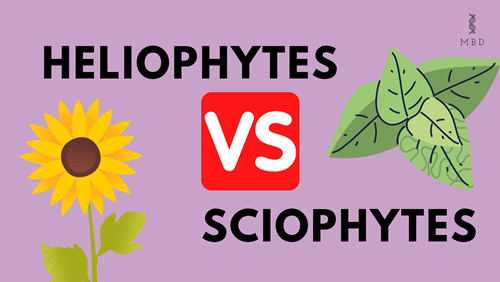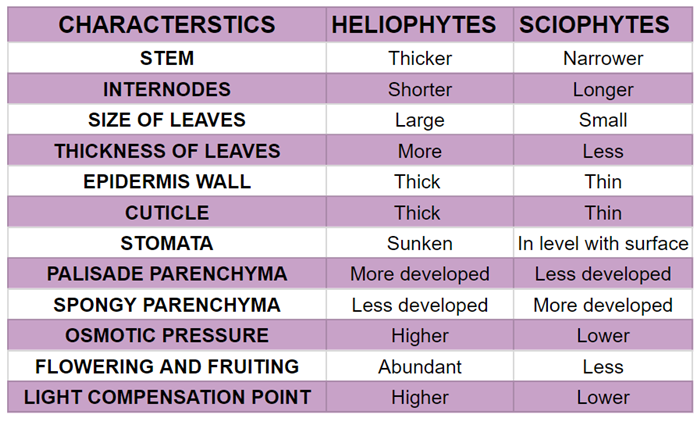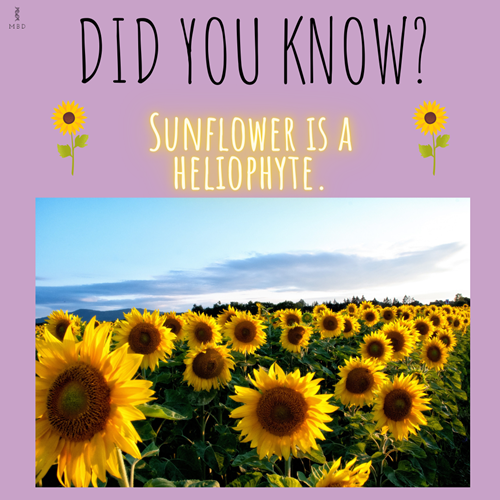Difference between Heliophytes and Sciophytes

Ever wondered if plants can also be divided into sun-loving and shade-loving? Well, yes just like humans have likes and dislikes based on their priorities to grow in life, so do plants! Various physiological processes of the plant such as photosynthesis, transpiration, germination of seeds, flowering etc are excessively affected by the abiotic factor light. The light intensity that particularly reaches the surface of the earth is affected by various governing factors like atmosphere, nature of suspended particles, water layers, layers of vegetation and topographic factors. Based on the effect of light intensity, plants can be classified as heliophytes and sciophytes.
Table of Contents
How does light affect plants?
Before we dig deeper into the difference between heliophytes and sciophytes, let us first look at the effects of light on plants-
- Chlorophyll Production– To begin with, plants need the abiotic factor light for the production of chlorophyll except for some algae and mosses that are green even without light.
- Heating action-Exposure of plant parts to light increases their temperature which particularly affects their physiological processes.
- Effect on the transpiration rate- Light affects the rate of transpiration process by increasing the temperature.
- Stomatal movement- Moreover, the opening and closing of stomata are governed by light.
- Distribution of plants- Finally, latitudinal variations lead to differences in light received by regions which further affects the distribution of plants.
Difference between Heliophytes and Sciophytes
Heliophytes
Plants that grow best in full sunlight are called sun-loving plants or heliophytes. Important characteristics of heliophytes are-
- They have thicker stems with shorter internodes.
- They exhibit particularly increased branching.
- Leaves are smaller and thicker.
- The size of the leaves is small with small chloroplasts.
- The epidermis is thick-walled.
- Moreover, the cuticle is thick.
- Stomata are present on the lower surface and are sunken.
- Palisade parenchyma is well-developed.
- Spongy Parenchyma is poorly developed.
- Osmotic pressure is high.
- Abundant flowering and fruiting are seen.
- The light compensation point is higher.
Sciophytes
Plants that grow well in shade are called shade-loving or sciophytes. Important characteristics of sciophytes are-
- They have narrow stems with longer internodes.
- They have few branches.
- Leaves are large and thin.
- The size of the leaves is large and the chloroplasts are also large.
- The epidermis is thin-walled.
- The cuticle is thin.
- Stomata occur on both surfaces and are at the same level as the surface.
- Palisade parenchyma is poorly developed.
- Spongy parenchyma is well-developed.
- Osmotic pressure is lower.
- Vegetative growth is more while flowering and fruiting are less.
- The light compensation point is lower.
Some heliophytes that grow best in full sunshine but can grow fairly well in shade are called facultative sciophytes and similarly, plants that grow best in shade but can grow fairly well in full sun are called facultative heliophytes.
Examples of Heliophytes and Sciophytes are as follows-
Heliophytes-For instance, Thymus vulgaris, Helianthus sp.
Sciophytes- For instance, Lycopodium
To summarize, hope this difference between heliophytes and sciophytes is useful to you all to understand important phenomena related to the field of Ecology. Keep reading at MBD!
Ciao!
Team MBD
Also checkout- Define heliophytes and sciophytes. Name a plant from your locality that is either heliophyte or sciophyte. (doubtnut.com)
You got to see this one too- The secret life of Honey fungus – My Biology Dictionary




